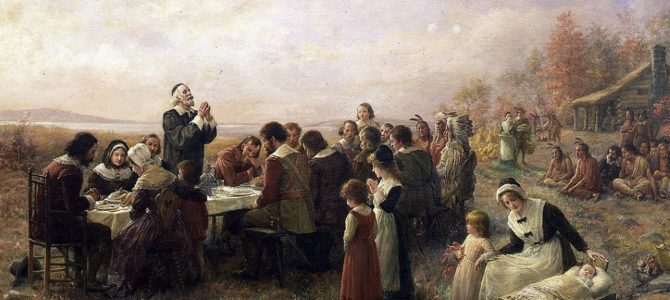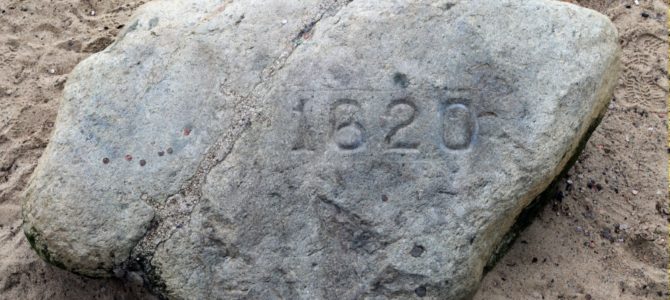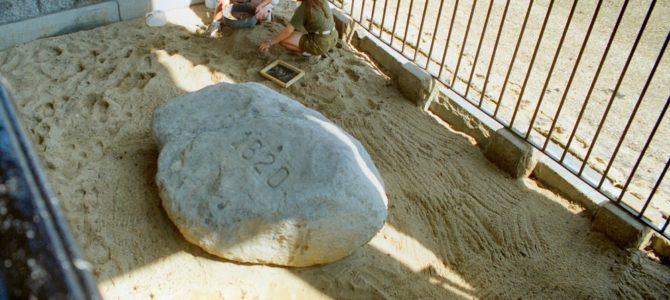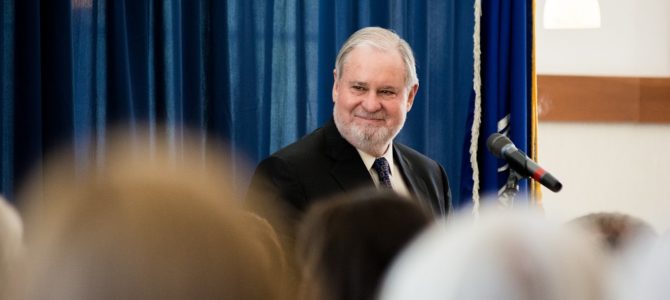
The following essay is part of The Federalist’s 1620 Project, a symposium exploring the connections and contributions of the early Pilgrim and Puritan settlers in New England to the uniquely American synthesis of faith, family, freedom, and self-government.
The Pilgrims who came ashore at Plymouth Rock in 1620 were followed by their theological cousins, the Puritans, who established Massachusetts Bay in 1630. They were not the first Europeans, not even the first Englishmen, to settle in North America. Yet they, more than any others, defined an American national identity and laid the foundations for an American political tradition committed to the rule of law and constitutionalism.
The Pilgrims were religious dissenters — theological separatists — who reluctantly concluded that the Protestant Church of England from which they separated themselves was irredeemably corrupt, whereas the Puritans, as their name suggests, held out hope that the church could still be purified. Both were profoundly religious people who had experienced oppression in England at the hands of authorities in church and state, and they crossed the Atlantic Ocean’s treacherous waters to escape religious persecution in the Old World and to seek religious liberty in the New World.
They were on a mission to establish Bible commonwealths grounded on biblical principles and laws as they understood them. These would be political communities devoted to their God and committed to the rule of law. Their bold experiments in self-government produced a constitutional tradition that blended biblical law interpreted through the lens of their Protestant theology, English common law adapted to the needs of their communities, and developing local customs. Key features of that tradition persist to the present day.
The First Foundation of Their Government
The Pilgrims’ condemnation of the established Church of England won them few friends in positions of power and influence in England. English authorities harassed them, fined them, and even threw them in jail. Their religious beliefs counseled that fleeing the persecution was preferable to fighting those who persecuted them. In 1608, members of their religious community went into exile in the Netherlands to escape oppression in their homeland.
After a decade or so in the Netherlands, the Pilgrims began to hear about opportunities in North America. So, a small group decided to leave Europe for America, arriving in New England in 1620.
Before leaving Europe, they made arrangements with the Virginia Company to settle in Virginia, but their tiny ship, the Mayflower, was blown off course by fierce storms crossing the North Atlantic, and they made landfall off Cape Cod, far north of their intended destination.
Their arrival in New England raised the thorny political question of whether they were subject to English authority — specifically, the Virginia Company — as they would have been had they arrived in Virginia as planned. There were mutinous murmurings among the non-Pilgrims aboard ship that their agreement with the Virginia Company was void, and they were at liberty to do as they willed. To erase any doubts about governing authority, the adult men aboard the Mayflower (both Pilgrims and non-Pilgrims) entered into a social contract with each other, with God as their witness, as they prepared to come ashore in New England.
This agreement has come to be known as the Plymouth Combination or, more famously, the Mayflower Compact. It was designed to nurture unity among the settlers and facilitate a future civil government. In the tradition of Old Testament covenants between God and His people, the agreement was made, the Pilgrims believed, “in the presence of God.” Underscoring the document’s sacred character, it began with an invocation: “In the Name of God, Amen.”
Remarkably, at a moment when the Pilgrims could have considered declaring their independence from English authorities, which might have been expected given their unhappy experiences in England, they instead made a covenant — a constitution of sorts — acknowledging their obligations to God, king, and country.
They were not a lawless or anarchic people. On the contrary, their agreement in November 1620 demonstrated a commitment to the rule of law and constitutionalism. William Bradford, one of their leaders, described the Compact in his journal as “the first foundation of their government in this place.”
A constitution is a political community’s expression of its fundamental, authoritative law, setting out the basic principles, substantive components, and procedural rules by which government power may be legitimately exercised. Scholars debate whether the Compact is a fully formed constitution; it is at least a proto-constitution committing its signatories to create a “Civil Body Politick” and to frame, enact, and obey “such just and equal Laws, Ordinances, Acts, Constitutions, and Officers” deemed necessary for the common good.
The very act and the manner of framing this agreement affirmed government based on the consent of the governed, the most cherished of American political ideals. The Compact, it has been claimed, is the oldest surviving declaration in the modern world asserting a people’s right to self-government.
The making of this Compact was, arguably, the most formative event in the New World in the development of an American constitutional tradition. Although a remarkably brief document, in its simple structure and form is a pattern evident in all subsequent American constitutions, including the national Constitution written in Philadelphia in the summer of 1787, which remains “the supreme Law of the Land.”
The Mayflower Compact, Willmoore Kendall and George W. Carey argue in “The Basic Symbols of the American Political Tradition,” set a template for written constitutions, and the same basic outline would be used by subsequent constitutional framers in North America. It begins with a clear identification of those for whom the document was created: “We whose Names are underwritten.” A similar statement of identity is expressed in the U.S. Constitution in the immortal words: “We the People.”
This is followed by a statement of the purposes for their political society: “for the glory of God, and advancement of the Christian Faith, and the Honour of our King and Country.” A corresponding statement of purposes for the national charter of 1787 is found in the noble aspirations of the Preamble:
… in Order to form a more perfect Union, establish Justice, insure domestic Tranquility, provide for the common defence, promote the general Welfare, and secure the Blessings of Liberty to ourselves and our Posterity …
The framers then entered into a solemn covenant to create a “Civil Body Politick” and the attendant “just and equal Laws, Ordinances, Acts, Constitutions, and Officers … thought most meet and convenient for the general good of the Colony.” “We … do ordain and establish this Constitution for the United States of America,” followed by six articles defining the structures, institutions, officers, and processes of the new constitutional regime, is the equivalent declaration in the U.S. Constitution. What’s missing from the Compact, that one might expect in a fully formed constitution, are the specific nuts and bolts of governance — this was left to be worked out in the future.
Then, in identical language — “In witness whereof we have hereunto subscribed our Names” — both the Mayflower Compact and the U.S. Constitution conclude with the signatures of its framers, indicating their pledge of mutual commitment and obligation to each other and to the common good. Finally, both documents are dated with reference to the birth of Jesus Christ.
Thus, the framers of and signatories to the Mayflower Compact established an outline and form for future American constitutions.
A City Upon a Hill
A decade later, John Winthrop, a lawyer and the first governor of the Massachusetts Bay colony, led a community of Puritans across the Atlantic to build a Bible commonwealth in New England. The Puritans, like the Pilgrims, left a legacy affirming the rule of law and liberty that to this day informs the American constitutional tradition.
Winthrop likely wrote “A Model of Christian Charity” — arguably the most influential “sermon” in American history — aboard the ship Arabella en route to New England. It outlined a visionary mission statement for a new community.
“Now the only way to avoid this shipwreck and to provide for our posterity,” Winthrop wrote, “is to follow the counsel of [the prophet] Micah: to do justly, to love mercy, to walk humbly with our God [Micah 6:8]. For this end, we must be knit together in this work as one man [Judges 20:11]. We must entertain each other in brotherly affection [cf. Romans 12:10].”
In rhetoric that still inspires centuries later, Winthrop concluded his charge to fellow immigrants with a phrase borrowed from Jesus’s Sermon on the Mount: “For we must consider that we shall be as a city upon a hill [Matthew 5:14]; the eyes of all people are upon us. So that if we shall deal falsely with our God in this work we have undertaken and so cause him to withdraw his present help from us, we shall be made a story and a byword through the world [2 Chronicles 7:20; Deuteronomy 28:37].”
Drawing deeply on scripture, Winthrop struck the major themes that would define the identity, mission, and political aspirations of his small Puritan commonwealth and the nation that later emerged on the American continent — a special calling and mission, the direction of an overruling Providence, a peculiar people in a covenant relationship with their God and with each other, a political commitment to virtue and justice, and a duty to be a beacon and model polity for the world.
Like the Pilgrims, the Puritans drew on their faith tradition, especially the Bible, in writing their laws because they feared that relying on the mind of man alone to frame their laws, given humankind’s fallen, sinful nature, would unavoidably taint their legal codes. The Puritan divine John Cotton remarked that “[t]he more any Law smells of man the more unprofitable.” The Puritans believed that the Bible, by contrast, was the revealed, perfect Word of God and authority in all matters of faith and practice.
Thus, biblical precepts, especially Mosaic laws, were woven into the fabric of early New England legal codes. And lest there be any doubt about the source, these written laws often included references to specific biblical authority for provisions contained in them. (The settlers, to be sure, did not adopt all aspects of biblical law, and the Bible was not the sole source of their laws.)
A decade after the Puritans had arrived in Massachusetts Bay, and after several failed attempts to frame a body of laws, the Massachusetts General Court approved the “Body of Liberties” in 1641, which was revised and expanded in the colony’s subsequent laws. It was to be a bulwark against the arbitrary and capricious exercise of government power. A seminal statement of Massachusetts law, it has been described as the first legal code in New England and the first colonial bill of rights.
Compiled by the Reverend Nathaniel Ward, the “Body of Liberties” borrowed from a draft code known as “Moses His Judicials” framed in 1636 by the Reverend John Cotton, the colony’s leading clergyman, which, in turn, was based largely on Mosaic principles. Cotton wanted to demonstrate the supremacy and sufficiency of God’s revealed Word for guiding a godly commonwealth in legal concerns.
Ward’s version drew on both English common law and Mosaic law with which he was familiar as a Cambridge-educated barrister and a Puritan minister. The final document contained familiar — sometimes harsh — features of Mosaic law, many of which had long before been incorporated into western legal traditions.
Like the Mayflower Compact, the “Body of Liberties” set out fundamental constitutional principles that would be emulated by other colonies and embraced by succeeding generations of Americans as essential to a regime of ordered liberty devoted to the rule of law. These liberties, Kendall and Carey observed, “have a familiar sound for our ears and would not at first glance seem to be out of place in a modern Bill of Rights.” Indeed, a half dozen or more liberties outlined in the document found expression in the national Bill of Rights written in 1789 and added to the Constitution in 1791.
The “liberties, immunities, and privileges … due to every man in his place and proportion,” the “Body of Liberties” began, are essential to social “tranquility and stability.” Accordingly, Massachusetts thought it necessary for the establishment of their civil government “to collect and express all such freedoms as for present we foresee may concern us, and our posterity after us, and to ratify them with our solemn consent.” Moreover, these “rights, liberties, and privileges” must be “impartially and inviolably enjoyed and observed throughout our jurisdiction forever.”
Massachusetts then demonstrated its commitment to these ideals by robustly affirming in articles 1 and 2 respectively the rights of due process of law in the protection of life, liberty, and property and equal protection under the law.
In subsequent sections, it recognized a right to trial by jury (art. 29), a right to a speedy trial (arts. 2, 41), a right to bail (arts. 18, 41), the protection of private property from a taking for public use without reasonable compensation (art. 8), a prohibition on double jeopardy (art. 42), a privilege against self-incrimination (art. 45), a prohibition on “inhumane, barbarous or cruel” punishments (arts. 43, 46), and a requirement that capital cases be supported by “the testimony of two or three witnesses” (art. 47). In discrete sections, it specifically recognized the liberties of women, children, servants, “foreigners and strangers,” and “brute creatures.”
Puritan conceptions of these rights, to be sure, are not the same as these rights are understood today. These rights would be developed and refined over the centuries. Nonetheless, the “Body of Liberties” planted the seeds of specific rights and liberties that would, over time, flourish on American soil.
Creating a Constitutional Tradition
The U.S. Constitution is a product of an American constitutional tradition that was, in significant respects, founded on New England’s Bible commonwealths. The national Constitution hammered out in Independence Hall in 1787 includes many features in design and content that would have been familiar to New England’s Bible-reading people. This is evident in the document’s covenantal character, like the Old Testament covenants and the Mayflower Compact.
Consider also the Constitution’s basic design, defined by the separation of powers and checks and balances. This reflected an awareness of original sin (Genesis 3) and the necessity to guard against the concentration or abuse of government powers vested in fallen human actors. This biblical anthropology, emphasized in the Protestant theology espoused by the Pilgrims and the Puritans, was expressed in the Constitutional Convention.
During debate on July 11, 1787, for example, James Madison acknowledged a fellow delegate’s strong view regarding “the political depravity of men, and the necessity of checking one vice and interest by opposing to them another vice & interest. . . . The truth was,” Madison concurred, “that all men having power ought to be distrusted to a certain degree.”
Other measures in the U.S. Constitution reflect biblical influences filtered through earlier expressions of law, including English common law and colonial codes and charters (such as those in Massachusetts). Among them are provisions recognizing “Sundays” in a clause on the president’s veto power, governing oaths and affirmations, requiring “the testimony of two witnesses” for conviction of treason, and promoting due process principles prohibiting double jeopardy and cruel and unusual punishments.
More generally, the influence of the Mayflower Compact and “Body of Liberties” on the U.S. Constitution are evident in its form, which follows that of the Compact; its affirmation of civil government by consent of the governed; and its protection of rights and liberties, including those enshrined in the “Body of Liberties.”
The U.S. Constitution and the constitutional tradition from which it emerged are, in no small part, a living legacy of a bold and innovative project in political self-government and liberty under law that began on New England’s rocky coasts 400 years ago and flourished in the years that followed.









